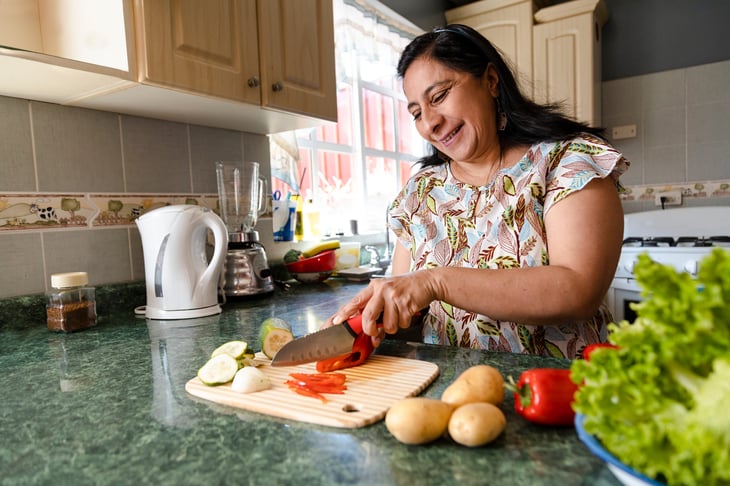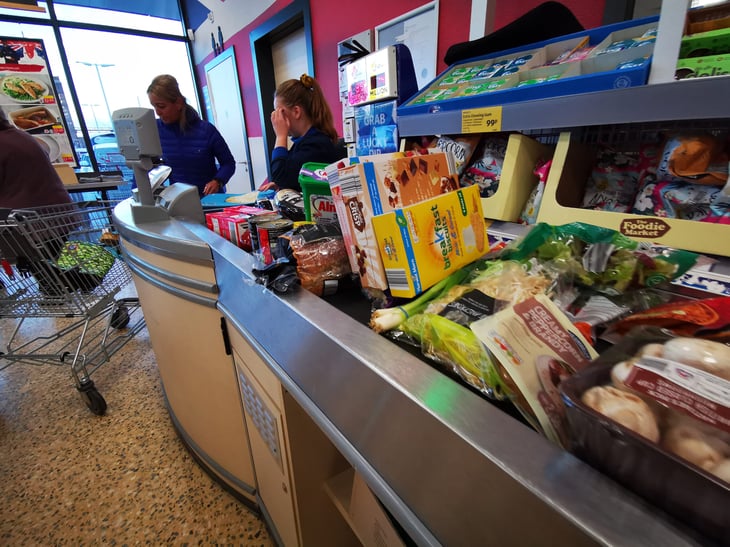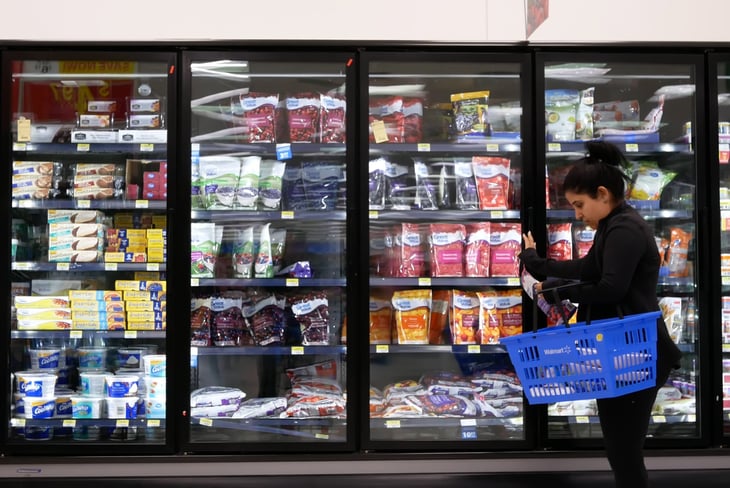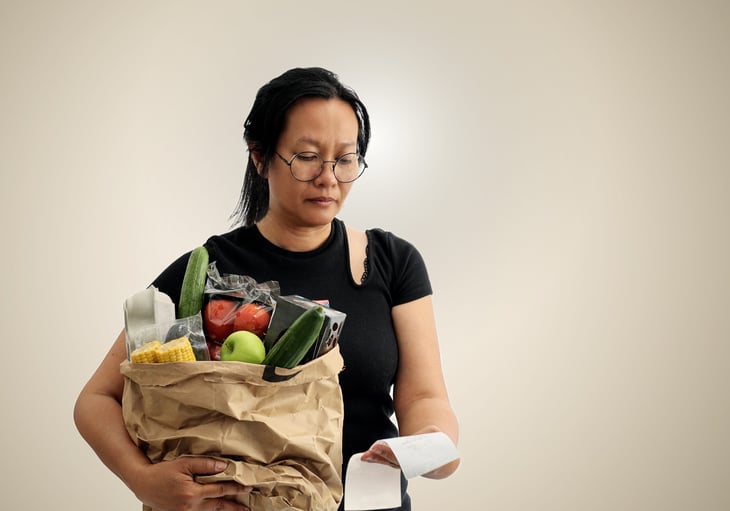
Editor's Note: This story originally appeared on Living on the Cheap.
Groceries for a family of four with young children cost an average of about $1,000 a month in the summer of 2023, not including takeout and restaurant meals, according to the U.S. Department of Agriculture.
That’s a big chunk of change.
But there are ways to spend less on food and still eat a healthy, nutritious diet. And you may be thrilled to hear that you don’t even need to clip coupons. In fact, experts say, other tactics may save you more money.
“I really challenge the assumption that coupons are the primary way to save money,” says Carrie Rocha, founder of Pocket Your Dollars and a mother of two in Minneapolis.
What’s more effective than using coupons?
Strategic shopping

Strategic shopping, or buying the things you use when they are on sale, Rocha says.
Ideally, you’ll purchase these staple items in large enough quantities to last until the next sale. If done correctly, smart shopping should save you more than buying at full price with coupons.
Stephanie Nelson, who runs the website Coupon Mom and is author of “The Coupon Mom's Guide to Cutting Your Grocery Bills in Half,” agrees. “Coupons are not the No. 1 way to save,” she says.
Stock up on sale items

Both experts advocate identifying the 10 or 15 items your family uses most often, with emphasis on the more expensive ones, tracking their prices and how often they go on sale.
“When something is on sale for a really good price, buy enough to get around to the next sale,” Rocha says.
For example, Nelson says her family eats about eight pounds of boneless chicken breast a week. She discovered that it’s on sale every other week at half the regular price per pound. By buying twice as much when it’s on sale, she can save $832 a year.
“I think the key is really honing in on what your high-impact items are,” Nelson says. “If you can find a less expensive source, it really adds up.”
Shop seasonal sales

One way to save on produce is to buy what’s in season: watermelon and berries in summer and citrus in winter, for example.
But even nonperishable items have a sale season, Rocha says. Canned soup, baking supplies, cold medicines, canned fruits and vegetables, baking supplies and oatmeal all appear at their lowest prices in winter.
Those items may go on sale in summer, she says, but not as often, and the price may not be as good.
“Sale prices are lower when an item is in season,” Rocha says, adding that coupon opportunities for additional savings are seasonal, too. “When products are in season, that is when there are coupons available for them.”
Summer products include condiments, barbecue sauce, hot dog and hamburger buns, sunscreen, adhesive bandages and antibiotic spray.
As Valentine’s Day approaches, look for sales on steak and potatoes, which will be discounted because of the number of couples planning to cook a romantic meal at home.
Do the math

Neither Nelson nor Rocha advocates shopping at warehouse stores as a top money-saving tactic, though that might be a good option for larger families.
Just remember that you won’t save money buying products you won’t use or such large quantities you’ll have to throw some out.
“Some people approach grocery shopping as a quest — me vs. groceries,” Rocha says. “If your quest is to save the most money, you may spend more.”
Here are ways to save money on groceries without clipping coupons.
1. Buy what’s on sale

This is the single best tip for most shoppers. Meat, bread, produce, condiments, coffee, cereal, pet food — nearly everything goes on sale from time to time.
Many products go on sale at regular intervals. Find out when your favorite grocery items go on sale, and try to buy just enough until you can get the next discount.
2. Buy what’s in season

This goes for both produce and nonperishable goods. Don’t plan a dish that requires fresh mango in winter, when the fruit is more expensive.
Instead, focus on oranges because they’re in season.
3. Use what you buy

Many families end up throwing away significant quantities of food, either because they get tired of leftovers or they don’t use items before they go bad. You can freeze or repurpose leftovers.
Rocha recently used leftover mashed potatoes to make shepherd’s pie.
You can also freeze most things not used immediately, including many fresh fruits and vegetables.
If you’re faced with a pile of broccoli and a bag of potatoes, Rocha recommends using the allrecipes.com “search by ingredient” section to find recipes for a meal with what you have on hand.
4. Don’t buy more than you need

A great sale is no deal if you end up throwing away half of what you bought. If you find yourself routinely throwing out produce, bread and meat, then you are buying too much.
Plus, not all items last forever, even if they’re unopened, as Rocha learned the hard way when she bought a quantity of olive oil on sale and it went bad before she opened it.
“I learned early on that overbuying is expensive,” Rocha says. Cereal and crackers won’t last long in humid climates, and family tastes may change as well.
5. Use store loyalty programs

Many stores require you to have a loyalty card to take advantage of sale prices. The cards are free and usually issued on the spot.
Some programs give you bonuses, like discounts on gas, for using your card.
Many allow you to “clip” coupons online and store them on your card, giving you an automatic discount at checkout.
6. Shop at discount groceries

ALDI and Save-A-Lot are expanding to more cities, and those no-frills stores can provide some good deals on staples, including produce.
And some of their store-brand products also are quite good.
“You can’t make the argument that the quality is lower because it’s at a discount store,” Nelson says. (Read our post on How to shop and save at ALDI to find out more.)
7. Try alternatives to your usual store

Most people have access to at least two grocery stores, as well as Walmart, Target and perhaps a discount grocery.
Visit other stores from time to time to see if they offer your favorite items at a price worth making an occasional special trip.
Nelson’s brand of coffee, for example, is $6 at her supermarket and $4 at Walmart, so she drops by Walmart occasionally to stock up.
8. Learn the sale cycles of your favorite products

If you live in an area with multiple supermarkets, the same products will go on sale, but not at the same time.
If you missed the half-price Cheerios at Kroger last week, you may find them at Safeway this week.
If your family eats a lot of yogurt, pay attention to how often your favorite brand goes on sale at the best price and stock up then.
Calculate the price per unit of larger containers versus individual containers — you can easily create individual portions at home using your own food containers.
9. Ask about markdowns

Talk to your store’s department managers in meat, dairy, seafood and baked goods to find out if there is a time of day that unsold products are marked down.
10. Find the store clearance rack

Discontinued products are often sold for half-price or less in sale bins. And you can use coupons to save even more on these items.
11. Buy store brands

Store brands of canned vegetables, cat food, paper products and many other items often are the same products sold under brand names.
It’s unlikely that you’ll notice any difference in taste in one brand of beans over another.
If you want to save even more, add coupons to this mix. Check out the advice from our Coupon Insider.





Add a Comment
Our Policy: We welcome relevant and respectful comments in order to foster healthy and informative discussions. All other comments may be removed. Comments with links are automatically held for moderation.